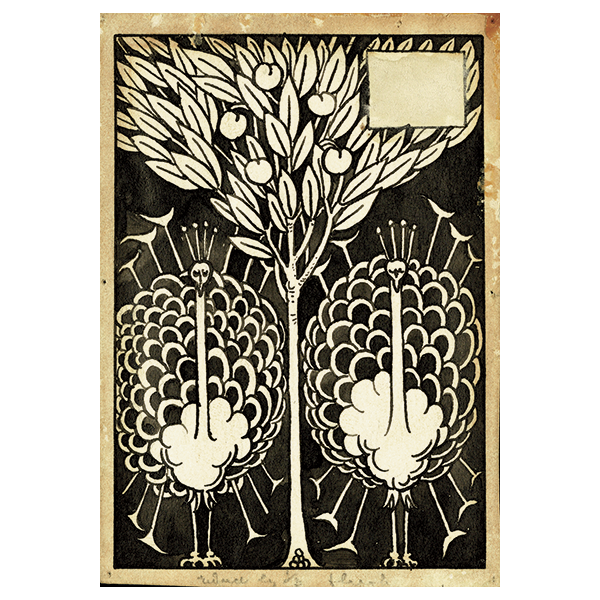
“Pray forgive my frankness when I say that two of them are not only not by A.B. [Aubrey Beardsley], but are not in the least like him! It is astonishing to me how many people are taken in. Is it not perhaps because they buy a name and not a work of art? I hope that is your excuse. But you are in good company.”
— R. A. Walker (1944)
So begins the chastising remarks made by Beardsley expert R. A. Walker in his June 1, 1944 letter to physician, friend, and fellow collector Adolphe Severn. Sharply critical of Severn’s recent purchase of two “Beardsley” drawings, Walker swiftly lays out the argument that they are forgeries: their composition is “inane and pointless,” the costume depicted is of a later era than that of Beardsley, and, most damningly, the drawings have a number of inconsistencies when compared with the published print of the same image. Dismissing the lot as an amateur attempt at collecting authentic Beardsley drawings, Walker’s suggestion to Severn is that he burn them both.
Walker’s words in this letter, his frequent lectures on the topic, and the publication of his 1950 booklet, How to Detect Beardsley Forgeries, are all testaments to the well-established market for Beardsley drawings, and—as Severn learned—for Beardsley forgeries. By the time Walker sent his letter to Severn, Aubrey Beardsley (British, 1872–1898) had been dead for almost 50 years. Beardsley’s illustrations are associated with the aesthetic and symbolist movements, and as such sought to express emotions and ideas instead of offering a visual translation of their associated texts. Beardsley’s innovative compositions, sense of balance, and elegant use of line were acclaimed by artists, designers, and architects alike in his time and for decades following his early death due to tuberculous.
Beardsley’s works were so influential that some early critics dubbed the 1890s “the Beardsley Period,” and as “Beardsley-mania” grew, so too did the prevalence of forgeries. The situation led one critic to note in a 1919 issue of Vanity Fair that Beardsley was “one of the most ‘faked’ of all masters.” Ever since, sophisticated forgeries have fooled many collectors and institutions. As suggested by Walker in his letter, Severn was indeed not alone in being taken in by these forgeries.
Severn, as is apparent in his later collecting and in subsequent letters from Walker, did take the latter’s suggestions for making more carefully informed collecting decisions. He did not, however, take his friend’s advice to burn the forgeries; today these and several authentic Beardsley drawings are part of the Aubrey Beardsley Art Collection at the Ransom Center. A section of the current Stories to Tell exhibition is devoted to examining these works, together with the means for discerning the fake from the authentic.
As Walker lays out both in his 1944 letter and How to Detect Beardsley Forgeries, historically much of the work of authentication has relied on close knowledge of the artist’s style, technique, and preferred materials, as well as on careful comparison of the drawing in question against the published print of the image. Today, this work of authentication is aided by sophisticated imaging equipment that allows close analysis of technique, materials, and process. These methods of detection are currently explored in Stories to Tell.

In this technique, Beardsley created an outline and then applied a pool of black ink directly to the paper, moving the ink with a pen to fill in the spaces between previously outlined shapes. As a result, hallmark traits of authentic Beardsley drawings include ink “tide lines,” shading inconsistencies due to the uneven amount of ink present, and the existence of visible outlines.
Because Beardsley’s images were directly transferred to the printing block via photo-reproduction, the resulting print did not require interpretation by a block maker. Accordingly, as Walker pointed out to Severn, the print is identical to the original drawing. Any inconsistencies indicate a potentially forged drawing, but some forgers were so skilled in their craft that even a side-by-side comparison between print and drawing can prove inconclusive.
Such is the case with the forged, highly detailed illustration “Dreams,” created for an 1894 edition of Lucian’s True History. Here, the skillful forgery is more clearly exposed with the use of high-powered imaging equipment from our conservation lab. The same tool reveals the forger’s reliance on white-ink corrections, a technique Beardsley would not have employed to such a great extent.
Visitors to the galleries can see these examples up close in the current display that features items from both the Aubrey Beardsley Art Collection and the Aubrey Beardsley Collection of manuscripts. The exhibition invites visitors to explore the ways in which conservators and curators work together not only to authenticate works of art but also to discover important information about technique, materials, and process.
Through August 18, 2019, the exhibition Stories to Tell: Selections from the Harry Ransom Center features materials that provide insight into the creative process while also establishing meaningful, personal connections between the past and the present.
